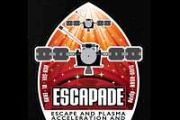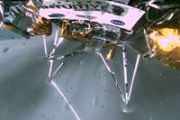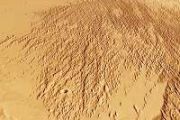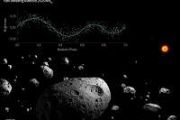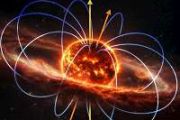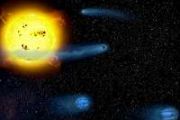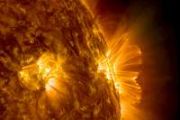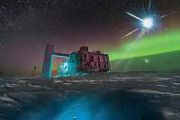
Copernical Team
New agreements for next decade of launches at Europe’s Spaceport in French Guiana

Webb scratches under Cat’s Paw Nebula for third anniversary

To mark its third year of highly productive science, astronomers used the NASA/ESA/CSA James Webb Space Telescope to scratch beyond the surface of the Cat’s Paw Nebula (NGC 6334), a massive, local star-forming region.
Trump taps transport chief to be interim NASA administrator
This request seems a bit unusual, so we need to confirm that you're human. Please press and hold the button until it turns completely green. Thank you for your cooperation!
Press and hold the button
If you believe this is an error, please contact our support team.
185.132.36.159 : dd23964a-bfc1-4da1-bc16-d55df80e
Redwire integrates second Hammerhead satellite for ESA in-orbit tech mission
 Redwire Corporation (NYSE: RDW) has finalized integration of its Hammerhead spacecraft platform for a European Space Agency (ESA) in-orbit technology demonstration mission. The work was completed at Redwire's satellite processing facility in Kruibeke, Belgium. As prime contractor, Redwire will support the European Union-funded In-Orbit Demonstration and Verification (IOD/IOV) mission, which aims
Redwire Corporation (NYSE: RDW) has finalized integration of its Hammerhead spacecraft platform for a European Space Agency (ESA) in-orbit technology demonstration mission. The work was completed at Redwire's satellite processing facility in Kruibeke, Belgium. As prime contractor, Redwire will support the European Union-funded In-Orbit Demonstration and Verification (IOD/IOV) mission, which aims How airports like Heathrow and Gatwick could help aliens spot Earth
 Radar systems used by civilian airports and military operations are inadvertently revealing our existence to potential advanced alien civilisations, new research shows.
The study explored how hidden electromagnetic leakage might look to extraterrestrials up to 200 light-years from Earth, if they had state-of-the-art radio telescopes like our own. Theoretically, it also suggests this is how
Radar systems used by civilian airports and military operations are inadvertently revealing our existence to potential advanced alien civilisations, new research shows.
The study explored how hidden electromagnetic leakage might look to extraterrestrials up to 200 light-years from Earth, if they had state-of-the-art radio telescopes like our own. Theoretically, it also suggests this is how Young lunar meteorite sheds light on missing chapter in Moon's volcanic timeline
 A meteorite discovered in Africa in 2023 has been dated to 2.35 billion years old, making it the youngest known basaltic lunar meteorite and filling a nearly billion-year void in the Moon's volcanic history.
Presented at the Goldschmidt Conference in Prague, the findings from the meteorite Northwest Africa 16286 offer compelling evidence that the Moon maintained internal heat far longer th
A meteorite discovered in Africa in 2023 has been dated to 2.35 billion years old, making it the youngest known basaltic lunar meteorite and filling a nearly billion-year void in the Moon's volcanic history.
Presented at the Goldschmidt Conference in Prague, the findings from the meteorite Northwest Africa 16286 offer compelling evidence that the Moon maintained internal heat far longer th Plate tectonics - Mineral olivine is crucial for heat transport in the mantle
 Due to the radiative thermal conductivity of the mineral olivine, only oceanic plates over 60 million years old and subducting at more than 10 centimeters per year remain sufficiently cold to transport water into the Earth's deep mantle. This was found by scientists from the University of Potsdam and from the Helmholtz Centre for Geosciences (GFZ) Potsdam, together with international colleagues,
Due to the radiative thermal conductivity of the mineral olivine, only oceanic plates over 60 million years old and subducting at more than 10 centimeters per year remain sufficiently cold to transport water into the Earth's deep mantle. This was found by scientists from the University of Potsdam and from the Helmholtz Centre for Geosciences (GFZ) Potsdam, together with international colleagues, Probing the cosmic Dark Ages from the far side of the Moon
 Astronomers want to unlock the secrets of the 'Cosmic Dawn' by sending a miniature spacecraft to listen out for an "ancient whisper" on the far side of the Moon.
The proposed mission will study the very early universe, right after the Big Bang, when it was still quite dark and empty before the first stars and galaxies appeared.
But to probe the cosmic 'Dark Ages', silence is essentia
Astronomers want to unlock the secrets of the 'Cosmic Dawn' by sending a miniature spacecraft to listen out for an "ancient whisper" on the far side of the Moon.
The proposed mission will study the very early universe, right after the Big Bang, when it was still quite dark and empty before the first stars and galaxies appeared.
But to probe the cosmic 'Dark Ages', silence is essentia Massive Boulders Ejected During DART Mission Complicate Future Asteroid Deflection Efforts
 University of Maryland astronomers discovered that an unexpected blast of space rocks ejected during DART mission carried three times more momentum than the spacecraft itself, leading to new insights for future planetary defense missions.
When NASA's DART spacecraft slammed into the asteroid moon Dimorphos in September 2022, it didn't just change the asteroid's orbit as intended-it unleash
University of Maryland astronomers discovered that an unexpected blast of space rocks ejected during DART mission carried three times more momentum than the spacecraft itself, leading to new insights for future planetary defense missions.
When NASA's DART spacecraft slammed into the asteroid moon Dimorphos in September 2022, it didn't just change the asteroid's orbit as intended-it unleash Continuing the Quest for Clays
 For the past month and a half, Perseverance has been exploring the Krokodillen plateau in search of clay-bearing rocks. An earlier blog discussed that these rocks could hold clues to Mars' watery past, and Perseverance has been exploring multiple potential locations to find a suitable target to sample.
When a coring target could not be found at the previous outcrop, the Science Team decide
For the past month and a half, Perseverance has been exploring the Krokodillen plateau in search of clay-bearing rocks. An earlier blog discussed that these rocks could hold clues to Mars' watery past, and Perseverance has been exploring multiple potential locations to find a suitable target to sample.
When a coring target could not be found at the previous outcrop, the Science Team decide 
